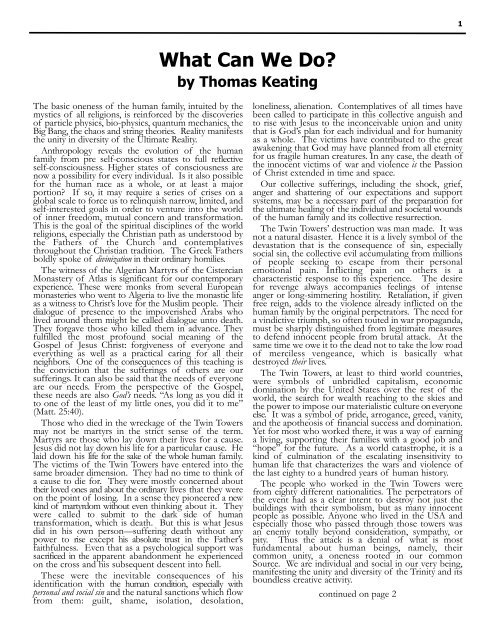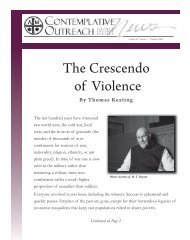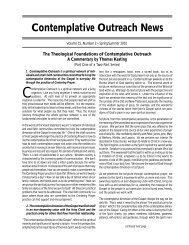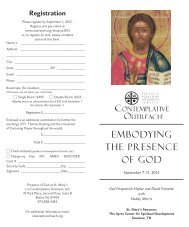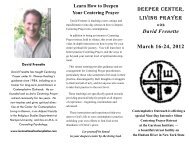Download pdf file in a new window - Contemplative Outreach
Download pdf file in a new window - Contemplative Outreach
Download pdf file in a new window - Contemplative Outreach
Create successful ePaper yourself
Turn your PDF publications into a flip-book with our unique Google optimized e-Paper software.
1<br />
What Can We Do?<br />
by Thomas Keat<strong>in</strong>g<br />
The basic oneness of the human family, <strong>in</strong>tuited by the<br />
mystics of all religions, is re<strong>in</strong>forced by the discoveries<br />
of particle physics, bio-physics, quantum mechanics, the<br />
Big Bang, the chaos and str<strong>in</strong>g theories. Reality manifests<br />
the unity <strong>in</strong> diversity of the Ultimate Reality.<br />
Anthropology reveals the evolution of the human<br />
family from pre self-conscious states to full reflective<br />
self-consciousness. Higher states of consciousness are<br />
now a possibility for every <strong>in</strong>dividual. Is it also possible<br />
for the human race as a whole, or at least a major<br />
portion? If so, it may require a series of crises on a<br />
global scale to force us to rel<strong>in</strong>quish narrow, limited, and<br />
self-<strong>in</strong>terested goals <strong>in</strong> order to venture <strong>in</strong>to the world<br />
of <strong>in</strong>ner freedom, mutual concern and transformation.<br />
This is the goal of the spiritual discipl<strong>in</strong>es of the world<br />
religions, especially the Christian path as understood by<br />
the Fathers of the Church and contemplatives<br />
throughout the Christian tradition. The Greek Fathers<br />
boldly spoke of div<strong>in</strong>ization <strong>in</strong> their ord<strong>in</strong>ary homilies.<br />
The witness of the Algerian Martyrs of the Cistercian<br />
Monastery of Atlas is significant for our contemporary<br />
experience. These were monks from several European<br />
monasteries who went to Algeria to live the monastic life<br />
as a witness to Christ’s love for the Muslim people. Their<br />
dialogue of presence to the impoverished Arabs who<br />
lived around them might be called dialogue unto death.<br />
They forgave those who killed them <strong>in</strong> advance. They<br />
fulfilled the most profound social mean<strong>in</strong>g of the<br />
Gospel of Jesus Christ: forgiveness of everyone and<br />
everyth<strong>in</strong>g as well as a practical car<strong>in</strong>g for all their<br />
neighbors. One of the consequences of this teach<strong>in</strong>g is<br />
the conviction that the suffer<strong>in</strong>gs of others are our<br />
suffer<strong>in</strong>gs. It can also be said that the needs of everyone<br />
are our needs. From the perspective of the Gospel,<br />
these needs are also God’s needs. “As long as you did it<br />
to one of the least of my little ones, you did it to me”<br />
(Matt. 25:40).<br />
Those who died <strong>in</strong> the wreckage of the Tw<strong>in</strong> Towers<br />
may not be martyrs <strong>in</strong> the strict sense of the term.<br />
Martyrs are those who lay down their lives for a cause.<br />
Jesus did not lay down his life for a particular cause. He<br />
laid down his life for the sake of the whole human family.<br />
The victims of the Tw<strong>in</strong> Towers have entered <strong>in</strong>to the<br />
same broader dimension. They had no time to th<strong>in</strong>k of<br />
a cause to die for. They were mostly concerned about<br />
their loved ones and about the ord<strong>in</strong>ary lives that they were<br />
on the po<strong>in</strong>t of los<strong>in</strong>g. In a sense they pioneered a <strong>new</strong><br />
k<strong>in</strong>d of martyrdom without even th<strong>in</strong>k<strong>in</strong>g about it. They<br />
were called to submit to the dark side of human<br />
transformation, which is death. But this is what Jesus<br />
did <strong>in</strong> his own person—suffer<strong>in</strong>g death without any<br />
power to rise except his absolute trust <strong>in</strong> the Father’s<br />
faithfulness. Even that as a psychological support was<br />
sacrificed <strong>in</strong> the apparent abandonment he experienced<br />
on the cross and his subsequent descent <strong>in</strong>to hell.<br />
These were the <strong>in</strong>evitable consequences of his<br />
identification with the human condition, especially with<br />
personal and social s<strong>in</strong> and the natural sanctions which flow<br />
from them: guilt, shame, isolation, desolation,<br />
lonel<strong>in</strong>ess, alienation. <strong>Contemplative</strong>s of all times have<br />
been called to participate <strong>in</strong> this collective anguish and<br />
to rise with Jesus to the <strong>in</strong>conceivable union and unity<br />
that is God’s plan for each <strong>in</strong>dividual and for humanity<br />
as a whole. The victims have contributed to the great<br />
awaken<strong>in</strong>g that God may have planned from all eternity<br />
for us fragile human creatures. In any case, the death of<br />
the <strong>in</strong>nocent victims of war and violence is the Passion<br />
of Christ extended <strong>in</strong> time and space.<br />
Our collective suffer<strong>in</strong>gs, <strong>in</strong>clud<strong>in</strong>g the shock, grief,<br />
anger and shatter<strong>in</strong>g of our expectations and support<br />
systems, may be a necessary part of the preparation for<br />
the ultimate heal<strong>in</strong>g of the <strong>in</strong>dividual and societal wounds<br />
of the human family and its collective resurrection.<br />
The Tw<strong>in</strong> Towers’ destruction was man made. It was<br />
not a natural disaster. Hence it is a lively symbol of the<br />
devastation that is the consequence of s<strong>in</strong>, especially<br />
social s<strong>in</strong>, the collective evil accumulat<strong>in</strong>g from millions<br />
of people seek<strong>in</strong>g to escape from their personal<br />
emotional pa<strong>in</strong>. Inflict<strong>in</strong>g pa<strong>in</strong> on others is a<br />
characteristic response to this experience. The desire<br />
for revenge always accompanies feel<strong>in</strong>gs of <strong>in</strong>tense<br />
anger or long-simmer<strong>in</strong>g hostility. Retaliation, if given<br />
free reign, adds to the violence already <strong>in</strong>flicted on the<br />
human family by the orig<strong>in</strong>al perpetrators. The need for<br />
a v<strong>in</strong>dictive triumph, so often touted <strong>in</strong> war propaganda,<br />
must be sharply dist<strong>in</strong>guished from legitimate measures<br />
to defend <strong>in</strong>nocent people from brutal attack. At the<br />
same time we owe it to the dead not to take the low road<br />
of merciless vengeance, which is basically what<br />
destroyed their lives.<br />
The Tw<strong>in</strong> Towers, at least to third world countries,<br />
were symbols of unbridled capitalism, economic<br />
dom<strong>in</strong>ation by the United States over the rest of the<br />
world, the search for wealth reach<strong>in</strong>g to the skies and<br />
the power to impose our materialistic culture on everyone<br />
else. It was a symbol of pride, arrogance, greed, vanity,<br />
and the apotheosis of f<strong>in</strong>ancial success and dom<strong>in</strong>ation.<br />
Yet for most who worked there, it was a way of earn<strong>in</strong>g<br />
a liv<strong>in</strong>g, support<strong>in</strong>g their families with a good job and<br />
“hope” for the future. As a world catastrophe, it is a<br />
k<strong>in</strong>d of culm<strong>in</strong>ation of the escalat<strong>in</strong>g <strong>in</strong>sensitivity to<br />
human life that characterizes the wars and violence of<br />
the last eighty to a hundred years of human history.<br />
The people who worked <strong>in</strong> the Tw<strong>in</strong> Towers were<br />
from eighty different nationalities. The perpetrators of<br />
the event had as a clear <strong>in</strong>tent to destroy not just the<br />
build<strong>in</strong>gs with their symbolism, but as many <strong>in</strong>nocent<br />
people as possible. Anyone who lived <strong>in</strong> the USA and<br />
especially those who passed through those towers was<br />
an enemy totally beyond consideration, sympathy, or<br />
pity. Thus the attack is a denial of what is most<br />
fundamental about human be<strong>in</strong>gs, namely, their<br />
common unity, a oneness rooted <strong>in</strong> our common<br />
Source. We are <strong>in</strong>dividual and social <strong>in</strong> our very be<strong>in</strong>g,<br />
manifest<strong>in</strong>g the unity and diversity of the Tr<strong>in</strong>ity and its<br />
boundless creative activity.<br />
cont<strong>in</strong>ued on page 2


